Rope Testing, Textiles and Packaging
We design tests to help manufacturers and users quantify the performance of a rope or cable.
Our forensic service helps establish the root cause of accidents and failures.
TTI has extensive experience in the testing and evaluation of textile and packaging materials and products, and offers consultancy services in these fields. The consultancy may be either for the purpose of research and development, or for the purpose of forensic analysis to establish the cause or causes of material and product failures.
TTI can also provide product design and development using both its internal resources and expertise as well as its extensive network of consultants. These consultants are leading specialists in their fields and come from both academic and industrial backgrounds.
Testing Services
At the main TTI laboratory, there are facilities for the tensile testing of a wide range of materials. There are a range of grips available that permit the testing of individual filaments and fibres, through to heavy duty grips capable of testing up to 25 kN. TTI has also developed additional software that allows more detailed analysis of Load/Extension curves. Figure 1 shows a combined load/extension and modulus/extension curve as an example of the extra analysis that can be offered.
Figure 1
Combined load extension and modulus/extension of a polyester textile yarn.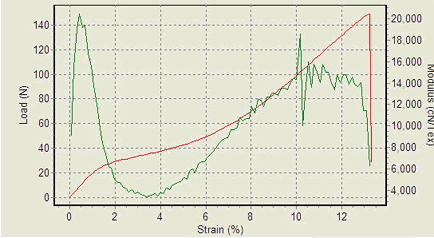
The red curve is the load/extension curve, and the green curve is the associated modulus/extension curve
Although a full range of standard testing methods is offered, it often happens that clients are looking for testing methods that are not conventional. TTI are skilled in developing specialised testing machinery and devices and in the past have built a range of testing machines to assess other material properties such as abrasion resistance, surface friction and buckling resistance. The abrasion resistance machines may be configured to test materials abraded either against themselves or against a standard surface.
A recent project was to test the performance under bending of very large GRP mud mats used on the base of a jacket as shown in Photograph 1. The mud mats were approximately 7 metres long by 3 metres wide, and had the shape of a box lid, but with reinforcing struts. TTI were not aware of any testing facility in the world that could undertake this work, and thus decided to build its own testing rig. The design chosen was to link two of these mats together at their corners, but to insert a flexible pressure bag between the two, to create a sandwich configuration. The bag was pressurised with water, thus expanding it against the two components. This resulted in a bending of both structures simultaneously. The test also simulated the field conditions anticipated, as the test design solved the difficult problem of applying even pressure over the entire surfaces of both mats. The structures were found to meet design criteria.
Photograph 1
Mud mats in position on the base of a jacket.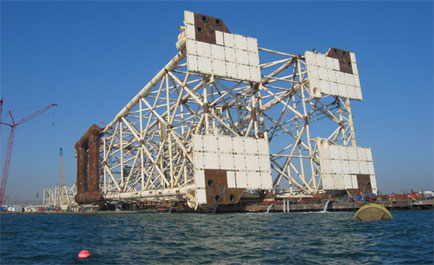
Mud mats are the white panels on the base of the jacket
Photograph 2 shows a bending test in progress. The deflection of the two linked mud mats is clearly seen.
Photograph 2
Mud mats under test.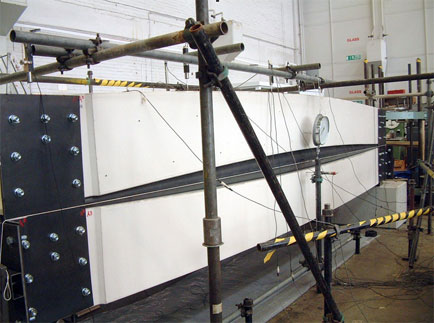
An increasingly important part of the material testing and evaluation service offered by TTI is optical and scanning electron microscopy. A recent project researching abrasion fatigue of polyester textile yarns involved the use of both optical and scanning electron microscopy to establish, visually, the levels of fatigue. This was then followed by a tensile test programme of the fatigued polyester filaments to correlate visual fatigue with actual tensile performance.
Forensic investigation of material and product failures is also an important part of the consultancy work conducted by TTI. Usually, the failure will be of a mechanical nature and the investigation of failures will only need to involve tensile testing and either optical or scanning electron microscopy. Photograph 3 shows an SEM image taken of mechanically damaged filaments as part of an investigation to determine the cause of failure of a polyester mooring rope.
Photograph 3
An SEM image of failed polyester filaments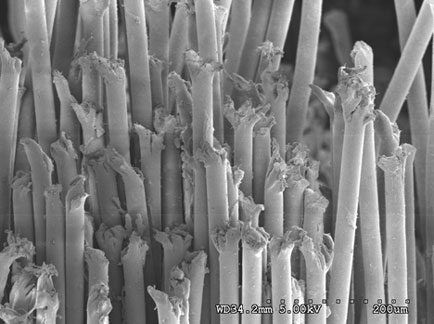
However, there are many other possible mechanisms of failure of textile and packaging materials. Where degradation, either thermal or UV, is suspected as a cause of failure, then other techniques must be used. TTI use both differential scanning calorimetry and infra-red spectrometry to determine the nature and extent of the suspected degradation.
Degradation due to chemical attack is also a possible mechanism for failure, and a range of surface analysis techniques may be used to establish what foreign materials are present.
Product Development
TTI will undertake, on behalf of clients, to design and develop products using technical textile materials. The capabilities of TTI in this aspect are well known in rope and rope termination design as well as in the design and manufacture of riser protection nets. Building on its knowledge of advanced textile materials, TTI have extended this service into other technologies where technical textile materials are key components. Heavy duty industrial packaging makes extensive use of high performance textiles, and is an important market for TTI. A recent project for a client involved the design, build and testing of a demonstration flexible container to hold 6000 kg of a mineral-based slurry.
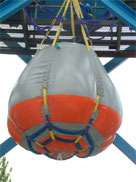
Photograph 4
The testing of a demonstrator flexible container of 6000 kg capacity.Photograph 4 shows a demonstrator being dynamically drop tested onto its lifting sling assembly. It successfully met the design specification of being able to withstand a retarding force of 36 tonnef.
In another technical field, a client was interested in reducing the manufacturing costs of a flood barrier defence system he had developed. TTI re-designed the system for the client using low cost polypropylene. Photograph 5 shows the re-designed concept.
Photograph 5
Demonstrator flood barrier system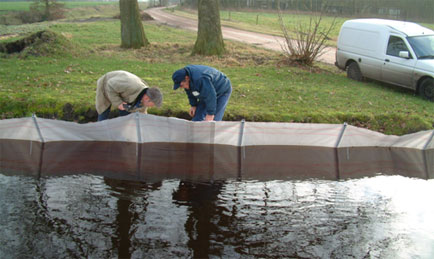
Additional services
Industrial packaging
TTI have knowledge and skills in the use of polypropylene in industrial packaging applications, particularly in a type of packaging referred to as a Flexible Intermediate Bulk Container [FIBC].Technical services are offered in all aspects of this type of packaging, from initial design through to forensic investigation. Technical advice on production is also available, from extrusion and weaving of polypropylene tape to printing and final assembly of the containers.
This product is manufactured and traded on a global basis, and TTI offers a third-party validation service to any purchaser of FIBC’s, who wishes to have confirmation that the products purchased are in line with the agreed technical specifications in terms of materials used and performance.
Modelling of textile materials
There is an important need for a comprehensive suite of software programmes that will allow the modelling of textile fabrics using a combination of a knowledge of the fundamental properties ot their component textile yarns and contemporary textile physics.TTI have supported research in this area for many years, and, in association with other partners, has set up a company, TexEng Ltd, specifically to market the results of this research.
Rope and Cable Textile Testing

/NQA-ISO-9001-Logo-UKAS.jpg)
/NQA-ISO-45001-Logo-UKAS.jpg)
